Our volunteer, Katrina Bishop and her partner Erin Holliday took the SNAP Challenge last month. Katrina offered her thoughts on her Instagram account about what it was like to live on such a limited food budget. She graciously gave us permission to repost her collection of SNAP Challenge entries here.
Take the SNAP Challenge during Hunger Action Month and share your meals with us.
Use the hashtags: #ARSNAPChallenge and #EndHungerNow
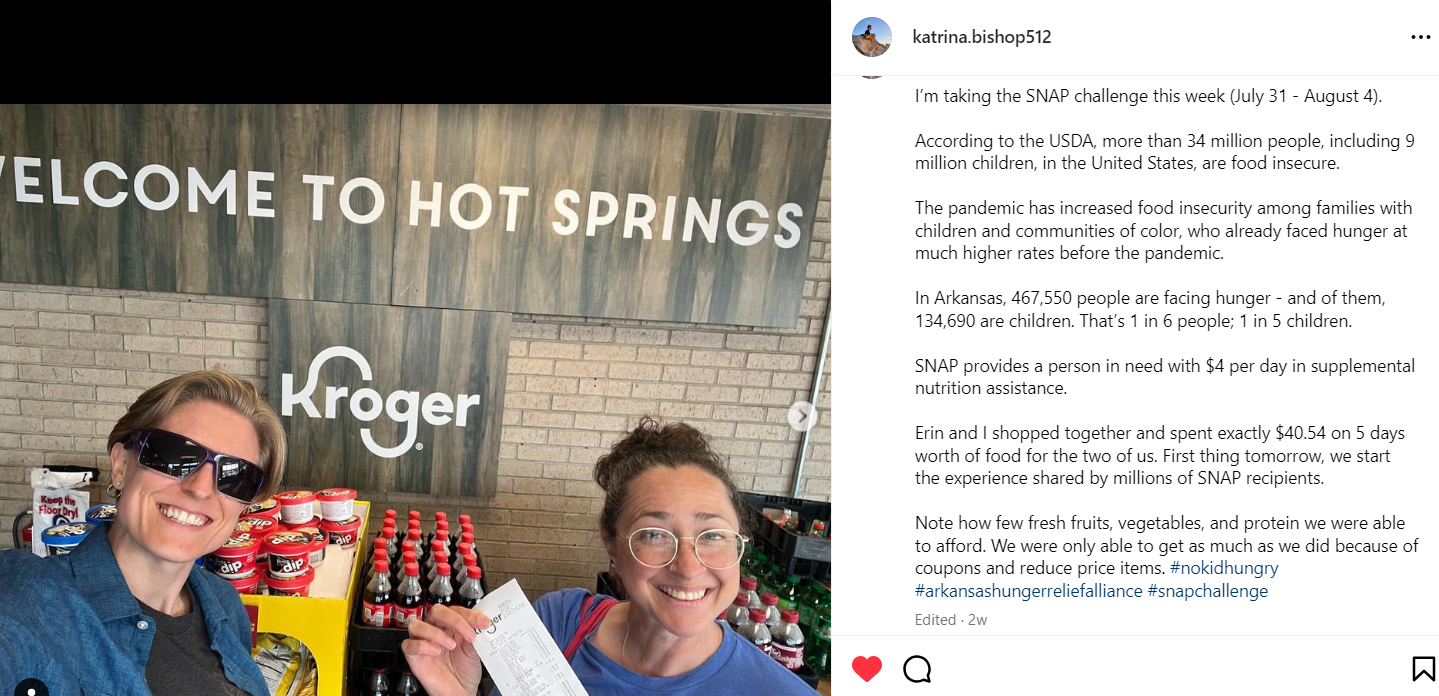
Monday, July 31, 2023 – day one of the SNAP challenge: The first day went okay. I felt like I ate a lot of starch, which isn’t my favorite, but it was sufficient. Full disclosure, I did have chips and salsa at Mexican restaurant between lunch and dinner. The details:
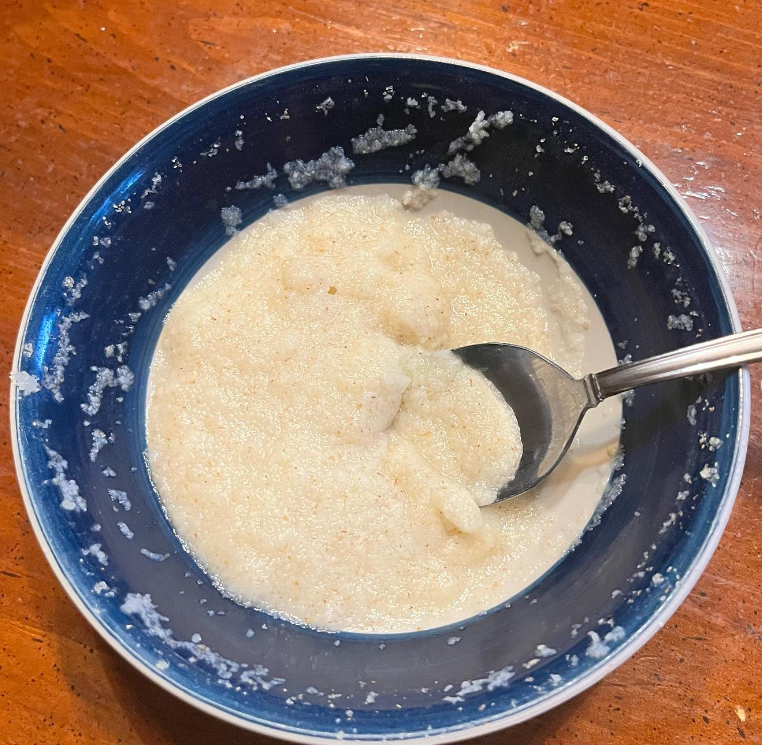 Breakfast: two packets of instant cream of wheat. Not as good as I remember, but not bad. I think if I were to add butter, cinnamon, fresh fruit, or honey, this would be a delicious breakfast but, we didn’t have room in our budget for those items.
Breakfast: two packets of instant cream of wheat. Not as good as I remember, but not bad. I think if I were to add butter, cinnamon, fresh fruit, or honey, this would be a delicious breakfast but, we didn’t have room in our budget for those items.
Mid-morning snack: several saltines and two spoon fulls of peanut butter. By 9:30 am, I was starving (this is pretty typical for me, regardless of the breakfast I have). The peanut butter/saltine combo curbed my hunger and was better than I remember. I’m just really grateful to not have a peanut allergy. According to Food Allergy Research and Education (FARE), 32 million Americans have food allergies – 1 in 10 adults, 1 in 13 children. Peanuts are one of the most common food allergies. Somewhat recent studies (from 2018 and 2019) estimate that 6.1 million people in the U.S. have peanuts allergies.
Lunch: tofu/veggie/potato scramble
Russet potatoes, Tofu, One bag of frozen veggies (red, green, and yellow bell pepper, onion)
Dinner: tuna noodle casserole
tuna, cream of mushroom soup, elbow noodles, frozen veggies (broccoli and cauliflower)
I’ve noticed that I am being very cautious with how much I’m eating. I’m trying to eat as little as possible to make sure that the food I have will last the entire week.
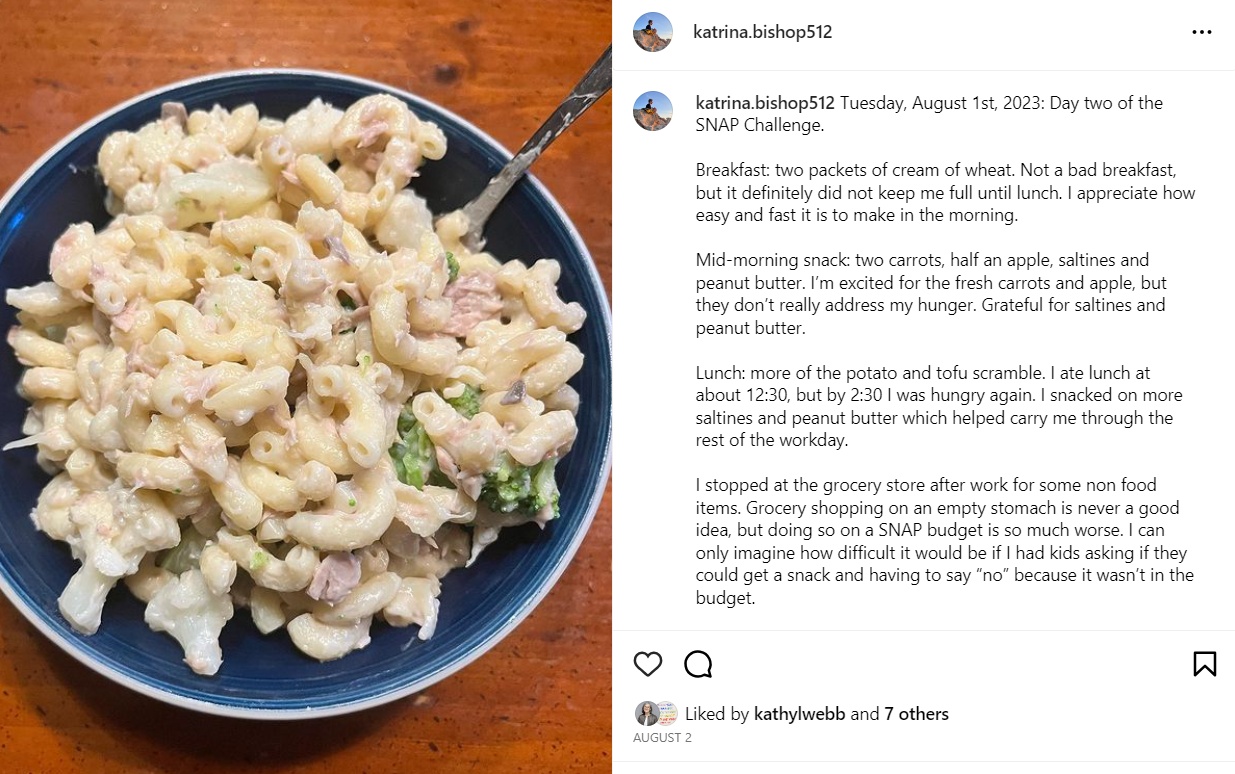

Wednesday, August 2nd, 2023: SNAP Challenge Day 3
Day three, this is what is left for the week – only an apple and four carrots for the rest of the challenge.
Today I was asked what my coping mechanisms are for dealing with the hunger. To be completely honest, knowing that the challenge is only five days and that on Saturday I’ll be able to eat whatever I feel like, has been my most effective coping mechanism. There’s a light at the end of this tunnel that many SNAP recipients don’t have.
Breakfast: two packets of cream of wheat.
Mid-morning snack: saltines and peanut butter, two carrots
Lunch: potato tofu scramble
Mid-afternoon snack: half of an apple
Dinner: tuna noodle casserole
Something that has been incredibly frustrating is the hard, woody bits of vegetables that I keep running into from the packages of frozen veggies. I have a small garden in my backyard and many of the peppers are about ready to be picked. I keep thinking how great it would be to use the fresh vegetables that I grow instead of buying frozen ones at the store. I’m reminded of what a privilege it is to have a backyard garden.
I’ve found myself craving sugar lately. I think this is because I’m not eating enough and I don’t have enough energy. Sugar seems appealing for the quick energy that it can provide. Furthermore, candy is relatively cheap and readily available – I can see how it might feel like a quick fix. All this has me thinking about how our diets impact our health and the association between poor nutrition and chronic health outcomes.
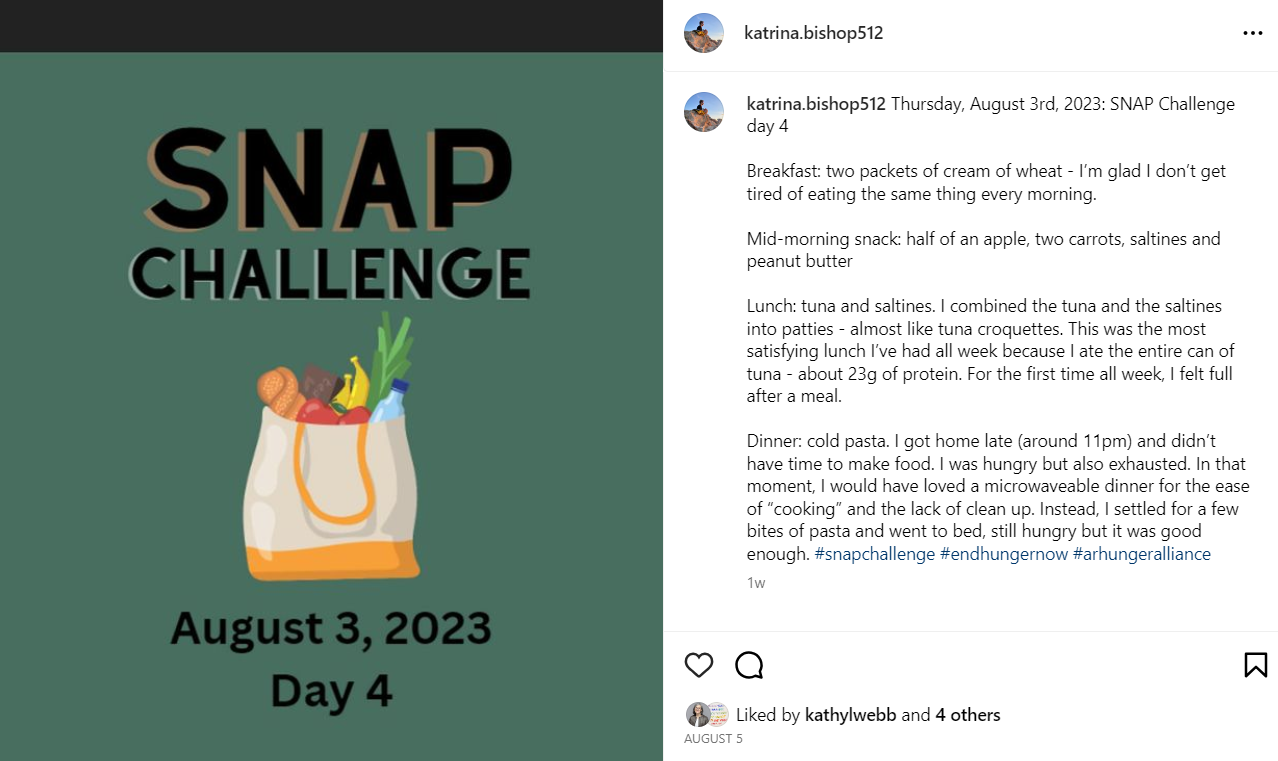
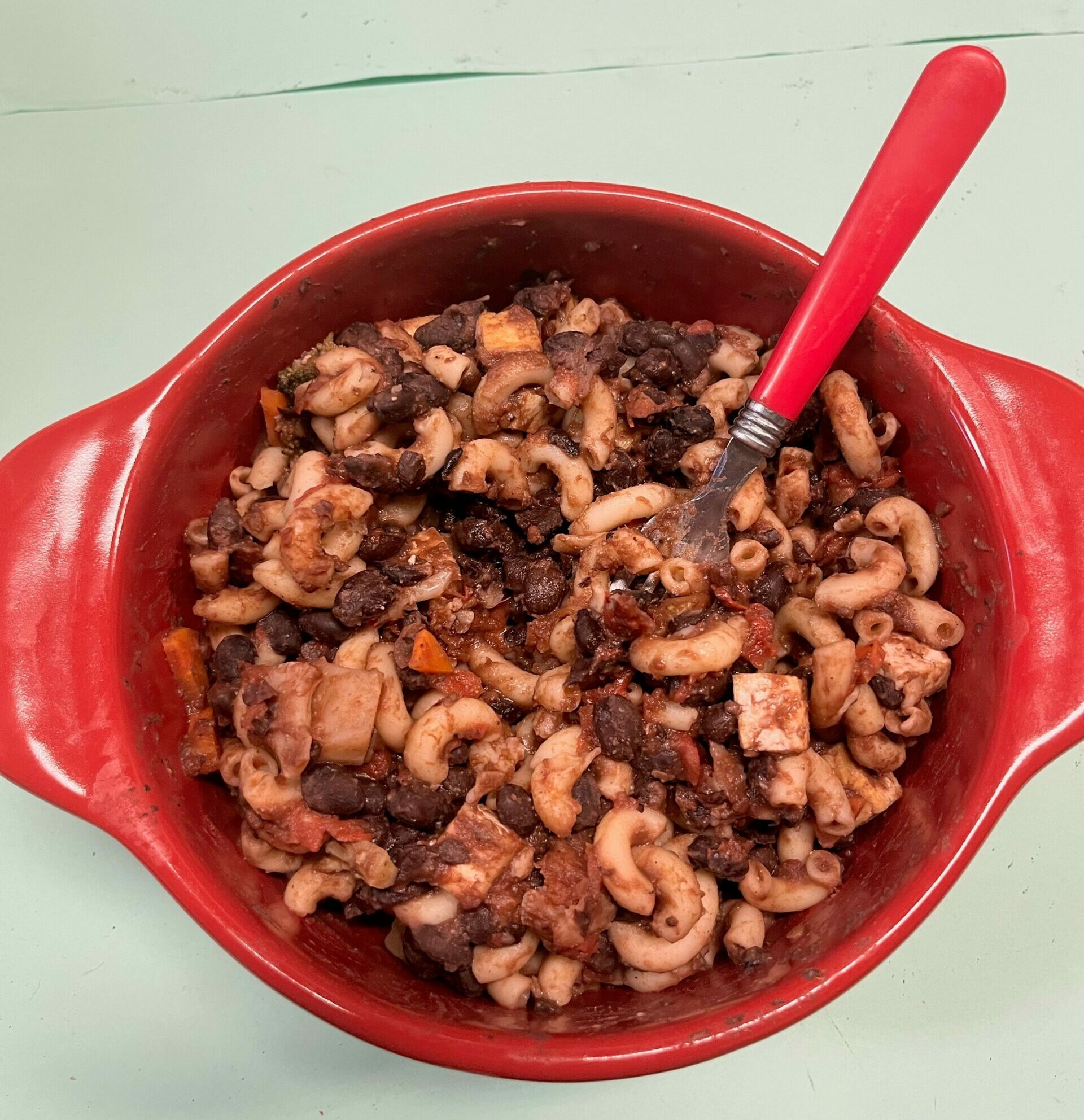 Friday, August 4th, 2023: SNAP Challenge Day 5 and recap
Friday, August 4th, 2023: SNAP Challenge Day 5 and recap
The last day!
Breakfast: same as every other day – two packets of cream of wheat
Mid-morning snack: half of an apple
Lunch: black beans, diced tomatoes, and rice
Mid-afternoon snack: another packet of cream of wheat
Dinner: Erin made us a delicious last meal with black beans, tofu, diced tomatoes, noodles, and the remaining frozen vegetables and carrots. By far, the best meal I’ve had all week.
SNAP challenge takeaways:
Even with all we know about food, we still over bought carbs because we were afraid we wouldn’t have enough food to last the week. I still have three potatoes, about a cup of uncooked rice, half a sleeve of saltines, and about a third of a box of noodles. Erin and I could have skipped rice or noodles and instead bought more tofu or tuna.
Two of the apples we purchased were rotten but we didn’t know until Erin cut into them. Normally, I would be frustrated, but this week, having so carefully planned our meals, it felt much worse.
Because of the limited budget, there was little variety in our meals. I have no doubt that if I were to continue this diet, I would become deficient in many of the necessary vitamins and minerals. I went to the doctor not long ago for a routine checkup and blood draw. My potassium and B12 were a little low. Typically, this is a relatively easy fix – I can add foods high in these things and get back to normal levels. On a SNAP budget, this would be much more difficult. Foods high in B12, like eggs and beef are incredibly expensive these days. It’s not hard to see how poor nutrition can quickly evolve into poor health and chronic health conditions, leading to lost productivity, crippling medical debt, and a strain on our health system.
Finally, something I’ve grown increasingly aware of because of this challenge: it’s cheaper to be “wealthy”. During the challenge and many times since, I’ve become more aware of the savings from buying in bulk. The problem is, a person needs to have the money upfront to pay for the larger quantity. This was the case for oatmeal during the challenge, but recently, I noticed it again when I bought new furnace filters. They were $22 a piece (for the ones that filter out everything). If I bought four or more, the price would drop to $11 per filter. I could save so much more money, but $44 (assuming I bought 4) is a lot, and may not be in the budget.
This extends to the quality of items as well. A good pair of shoes may cost $200 but will last years and in some cases, can be resoled. Another pair, say $80, might be more affordable, but won’t last as long and will need to be replaced every year or even every six months. The person who can only afford the $80 shoes ends up spending much more money over time.
Two things to add to this challenge:
- I think the challenge should be extended to a full month instead of one week. Doing so would change how the participant plans meals and would give the participant a better understanding of the impacts of malnourishment. Furthermore, I believe SNAP benefits are paid out once a month. I think there is an opportunity to learn how this impacts food purchasing decisions.
- I think there should be a challenge/competition to make the best tasting meal that feeds a family of four based on a SNAP budget with only SNAP eligible foods. Winning recipes can be combined into a SNAP cookbook and given out when someone begins receiving SNAP benefits for the first time.
